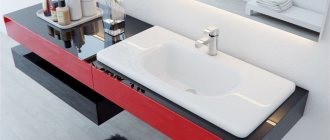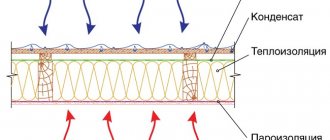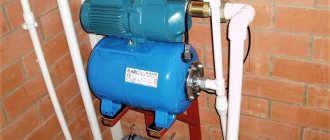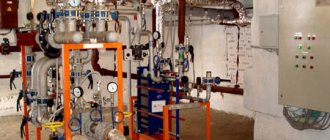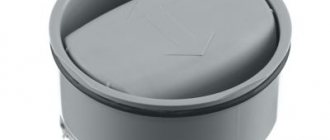Modern people are so accustomed to communal amenities that they sometimes don’t understand how they work. Many of us begin to become interested in this when the issue of repair is brewing.
Thus, installing the same washbasin requires certain knowledge of how to choose a sink drain, install a siphon and connect the system to communications.
Each installation stage has its own nuances, knowledge of which will help protect the drain structure from leaks during operation.
Why does a sink need outlet fittings with an overflow?
We all know the problem when the drains from the sink stop flowing or don’t flow well. This is usually a consequence of clogged drain fittings with grease deposits or pieces of solid waste. Since this situation repeats itself periodically, some may have the idea of connecting the sewer directly, eliminating the problematic siphon for the sink. Naturally, such a connection will help get rid of frequent small blockages, the outflow will speed up, since there will be no additional resistance to the flow, however, a number of other undesirable consequences will appear:
- unpleasant odors from the sewer;
- midges and other insects living in sewage areas;
- blockages in the depths of drain pipes, which are quite difficult to eliminate;
- If you accidentally drop a small valuable item, such as a ring, into the sink hole, you can say goodbye to it forever.
Siphon with overflow - protection against floods
Therefore, in order to prevent these troubles, you cannot do without installing drain fittings. In addition, an outlet for a sink with an overflow will save you and your neighbors from natural floods as a result of its accidental overflow.
Conclusion
Installing an under-sink drain system is not difficult, but it is extremely important to follow the guidelines above. Otherwise, a leak may appear, which will not allow the structure to be fully operated and will force you to repeat the whole process all over again. In addition, it is fundamentally important to be able to clean the drain, since it sometimes becomes clogged.
The video in this article will introduce you to additional information that is clearly related to the materials discussed. Be careful during assembly and you will succeed.
The structure of siphons
Siphons, regardless of their type, have approximately the same design and a similar operating principle. They are a metal or plastic pipe or a pipe system that includes pipes and a tank.
On one side, the devices are connected to the drain opening in the sink, on the other, they are connected to the sewer system. The used water flows into the siphon, then passes through the pipe and enters the general sewer riser.
The system is protected from clogging by a mesh filter located at the sink opening. The slightly curved shape is given to the siphon for a reason: a certain volume of liquid is retained at the bend, forming a so-called water seal. It is this that prevents unpleasant odors from getting inside from the sewer.
It is desirable that the connecting screw for the siphon be made of stainless steel. Regular coated metal rusts too quickly during use.
The standard equipment set includes the following elements:
- metal grate for drainage - the optimal cell diameter is no more than 10 mm;
- inlet/outlet pipe;
- connecting screw with a diameter of up to 8 mm;
- frame;
- union nuts;
- sewer outlets;
- O-rings for sealing joints.
If the siphon is equipped with an overflow function, then the package includes an additional pipe, which is attached to the overflow hole in the sink.
The water seal in the siphon becomes a reliable barrier that prevents odors from the sewer from entering the room.
Some models have special side fittings for connecting hoses of household appliances (washing machines, dishwashers). Products for sinks with two bowls are equipped with a duplicate outlet.
Purpose and design
The device is divided into a pipe and a bent siphon, which helps protect the apartment from the unpleasant odor that spreads from the drain.
The design prevents the water drain pipe from clogging with solid particles coming from plumbing fixtures.
How does a siphon drain work?
During draining, the liquid flows into the siphon, passes along the bend, rises and enters the sewer. In this case, part of the water remains in the lower part of the curved tube. It is a hydraulic seal that does not allow odors to pass through. The curved section of the siphon traps solid particles and small objects. To clean this area, the parts are removed and reinstalled after cleaning.
Siphon dimensions
If the dimensions of the drain do not correspond to the diameter of the sewer pipe, then installation will be problematic. In addition, the throughput of the device is important. Another important thing is the length of the interval between the exit to the sewer and the siphon.
According to the standard, the device has a length of 75 centimeters. Usually, a piece of pipe is enough to connect it, but various situations arise, so it becomes necessary to purchase adapters. They are still needed when the exit to the sewer is not opposite the drain.
Connection diagrams with dimensions
The entrance to the sewer under the washbasin is most often mounted at a height of about fifty centimeters. The diameter of the inlet pipe varies from 30 to 92 millimeters, so the pipe must be the right size or thinner. If the diameter does not match, then all that remains is to install an adapter.
The need to purchase an adapter also arises in cases where the sink has an unusual design. For example, this applies to products with a pedestal. Under such circumstances, the compact drain will not be visible inside.
How to determine pipe sizes
Foreign-made polypropylene, polyvinyl chloride and other plastic communications are most often designated by inches. It may also be that you need to install fasteners on the pipeline, but its dimensions are also given in inches, while the pipe is indicated in mm.
Pipe inch thread
To do this, you need to convert the known inch dimensions into millimeter ones. According to the data, 1 inch is 25.4 mm. It turns out that a pipe with a diameter of 2 inches = 50.8 mm, etc. Fractional values are very often used, this is how clamps, fittings, couplings and communications are marked.
Let's look at their meaning in the table:
| In inches | In millimeters | In inches | In millimeters |
| 1/8 | 3,2 | 1 1/8 | 28,6 |
| 1/4 | 6,4 | 1 1/4 | 31,8 |
| 3/8 | 9,5 | 1 3/8 | 34,9 |
| 1/2 | 12,7 | 1 1/2 | 38,1 |
| 5/8 | 15,9 | 1 5/8 | 41,3 |
| 3/4 | 19 | 1 3/4 | 44,4 |
| 7/8 | 22,2 | 1 7/8 | 47,6 |
| 2 1/8 | 54 | 3 1/8 | 79,4 |
| 2 1/4 | 57,2 | 3 1/4 | 82,6 |
| 2 3/8 | 60,3 | 3 3/8 | 85,7 |
| 2 1/2 | 63,5 | 3 1/2 | 88,9 |
| 2 5/8 | 66,7 | 3 5/8 | 92,1 |
| 2 3/4 | 69,8 | 3 3/4 | 95,2 |
| 2 7/8 | 73 | 3 7/8 | 98,4 |
PVC pipes of different diameters
But, when measuring a socket manually, for example, with a ruler, the nearest minimum size is always taken. For example, the diameter in millimeters of a sewer pipe for a sink is 34. It turns out that the outer diameter is 1 ¼ inches. Be careful when selecting sizes, otherwise you will have to buy additional spacers or adapters. But the coupling is selected based on the nearest larger indicator, i.e., 34 mm will be considered 1 3/8 inches.
Video: Joining pipes of different diameters in the sewer system.
Steel two-way communications may have different indicators on different sides; you need to double-check the data. This can be done by experimental measurements with a caliper or plug gauge.
Table: Diameters of ceramic pipes
Operating principle of siphons
A simplified scheme of operation is as follows: water from the sink or sink goes into the flask through the outlet of the siphon, passes through a pair of settling pipes and goes into the sewer through the outlet pipe. If the siphon is installed correctly, a water seal is formed that does not release unpleasant odors from the sewer.
They can enter the room only if the plumbing has not been used for some time, for example, during the absence of the owners. Odors are eliminated by flushing the toilet or opening the water tap to restore the water seal.
Siphon designs are constantly changing. You can choose, for example, a bottle siphon with a wide or standard outlet, with one or two outlets.
Advice! The siphon parts are connected using rubber cone gaskets. The reliability of the siphon connections and the absence of leaks depends on their quality.
The gaskets should be elastic and fit onto the tube with some effort.
If the gasket is of poor quality, then, for example, the siphon bulb, which is attached to the tube with its help, may fall off at the most inopportune moment.
What is overflow
An overflow is an additional tube that is removed from the sink and connected to part of the siphon or its pipe. It prevents water from overflowing over the edge of the sink. The water, having reached the second hole in the sink, located close to its edge, begins to calmly flow down the overflow into the sewer. Thus, flooding of an apartment with such a design is unlikely. Accordingly, recently the demand for such a model is significantly higher than for siphons without overflow.
Device classification
There are two main classifications used:
- by design features;
- according to the method of removing liquid.
According to the design features, the siphon for air conditioners can be of 4 types:
Device with water seal
It has an arched shape. The two tubes are connected to each other by a special element in the form of an elbow. The knee plays the role of a water seal mechanism. This type of siphon is simple and popular, but has a number of disadvantages: large size; an excellent environment for the development of fungus and bacteria, which can spread to the air conditioner itself; With rare use, the water in the unit dries out and an unpleasant odor spreads from the siphons.
Unit with water seal and odor-locking mechanism
It is similar in design to the first type, but has a small ball-shaped valve that limits the spread of odor from the body. The valve freely allows condensate from the split system to pass through, but does not allow liquids and odors from the sewer to pass through. Such models are complemented by devices for collecting dirt and cleaning pipes.
Boxed device for flush mounting
The entire condensate drainage system is located in a square (rectangular) plastic box. There are 2 pipes connected to the box: from the system drainage and to the sewer. The elbow with the ball odor-locking device is located in the box. The device operates on the principle of a float; when water enters the siphon, the ball that closes the hole into the sewer floats up. As soon as the water leaves the device, the ball, under its weight, closes the hole again.
The siphon is designed in such a way that, if necessary, it can be easily removed from the box for cleaning and replacement.
Dry aggregate
Used in cases where it is not possible to install a conventional condensate drainage device. The siphon is equipped with a compressed rubber tube, which perfectly inhibits the spread of odor. It allows condensate to pass through using the drip principle: the valve opens as liquid passes through and contracts again.
This dry siphon is used in combination with a straight adapter and a funnel.
According to the method of removing liquid, the siphon for air conditioner drainage can be of 3 types:
- with vertical outlet;
- with horizontal outlet;
- combined type.
The siphon for air conditioners is mounted in two ways. If possible, the device is hidden in the wall. A special niche is made for this. If there is no way to hide the unit, it is mounted openly, along the wall.
Manufacturers of siphons for climate control equipment:
- Profcool (Russia).
- Vecam (Italy).
- HL (Austria).
Types of plumbing fixtures with different outlet heights
There are different designs of sinks equipped with a stand or cabinet (pedestal). There are also a number of models designed for wall-mounted installation. Open structures in which the sewer outlet goes into the wall require an accurate calculation of the height of the pipe placement. If a wall-hung toilet is used, the horizontal part of the system is installed in a hidden way and hidden in the wall. The pipeline is laid in a recess in the floor, and then it is masked with a cement screed and floor covering. In such situations, the height of the sewer for the sink is determined by the difference in the level of installation of the pipes.
It is necessary to take into account that the parameters for the location of the sewerage system often depend on the characteristics of the water supply. Pipes placed on the surface of the wall do not allow the sewer system to be installed as needed, forcing one to adapt to existing conditions. Most often, the height of the outlet of water and sewerage pipes depends on each other and requires taking into account the specifics of installation or connection. When installing a water supply system, you should remember about the sewerage system, and vice versa.
The lowest outlet level required for shower enclosures is 60 mm. Most often, they have to draw their own line, located much lower than the common horizontal plank. For example, they build a podium of the appropriate size on which a shower stall is installed.
You may also like: Connecting the sink to the sewer yourself
Common types
Manufacturers produce several types of sink siphons. They are selected depending on the characteristics of the installation site.
Some types of siphons: bottle with a tube, bottle with partitions, tubular
Corrugated drain
The corrugated tube is convenient to use when the sink drain hole has a non-standard location. This device is also used if you plan to install additional equipment or some necessary items under the sink
When connecting it to the sink, you need to pay attention to the amount of water in the curved place. It should be enough to create a reliable water lock, which guarantees reliable protection against the penetration of odors from the sewer
A drain in the form of a corrugated tube is not an ideal design, because dirt quickly accumulates on the ribs of the product.
Structurally, the corrugated siphon consists of the following elements:
- pipe with grille and union nut;
- corrugated tube
Additionally, pipe fastening may be required.
Drain with corrugated pipe
The corrugated drain is installed in a matter of minutes. First, we attach the outlet pipe with the grate to the sink. Fixation is carried out using the gasket and screw included in the kit. Then the corrugation is inserted into the pipe at one end and secured with a nut, and the other side is inserted into the sewer pipe. If cleaning is necessary, the corrugated hose is disconnected from the pipe and the sewer. Then it is washed or replaced with a new one.
Bottle drain
Bottle siphons are most often installed. They are well suited when you need to drain dirty water and other waste from multiple sinks. In this case, the required number of special bends is installed.
The design of the bottle drain consists of the following elements:
- metal or plastic grille;
- intake pipe;
- bottle container;
- pipe for draining sewage into the sewer;
- a transition piece that allows you to connect the siphon to the sewer system.
Bottle drain is a completely rigid product
If necessary, the design is supplemented with corrugation for more convenient connection to the sewer. Cleaning the bottle drain is done by unscrewing the bottom part of the bottle-shaped container and removing accumulated dirt.
Pipe drain
This type of siphon is installed not only on sinks, but also on bathrooms. It has a completely rigid structure - outwardly similar to the letters S and U.
Since many modern kitchens have dishwashers, the pipe siphon may have an additional outlet.
Straight pipe (direct flow) siphon
Pipe siphon for sink McAlpine (UK) with outlet for household appliances, 40 mm (MRSK6). The MRSK4A model is equipped with an angular outlet. When choosing, be guided by the specified sizes
There are models of tubular siphons with a break in the stream flow. Such siphons are not attached to the sink - after installation there is a difference between the siphon and the sink. It is necessary to prevent germs from the sewer from entering the sink. They are used in preschool institutions and catering establishments.
Flat drain
This is a small siphon under the sink, where size is critical. It is usually used when a “washing machine” or dishwasher is installed under the sink. There are models with a break in the jet flow.
The design is a regular knee, but it saves space
In addition to small dimensions, a distinctive feature of a flat drain is also its rigid design. Such siphons rarely become clogged. If there is a need to perform a complete cleaning, the grille is unscrewed, and then the entire structure is removed from the sink.
With overflow
When the sink has overflow protection, a siphon with overflow is installed under it. The design of the product includes an additional pipe, to which a small diameter tube is connected from the overflow hole in the upper part of the sink. This design prevents the sink from overflowing with water and reduces the risk of flooding the room and neighbors living on the floor below.
A siphon with overflow is installed not only for sinks, but also for sinks
There are also drains with one or two outlets at the neck. They are used when it is necessary to additionally connect a dishwasher or washing machine.
The overflow tube connected to the tee body can be corrugated or rigid. At the same time, rigid pipes are produced both solid, for certain models of plumbing, and sliding, the length of which can be adjusted for a specific model of equipment.
Overflow pipe siphon for two sinks
The drainage from the overflow unit enters the water seal (the lower part of the siphon), the design of which determines what type of siphon for the kitchen sink is.
Please note how many components a pipe siphon with overflow has. If you are afraid of getting confused when installing it yourself, it is better to invite a professional plumber.
Click-clack
A special valve is mounted between the water seal and the drain device. Thanks to the spring inside, they regulate the discharge of water from the bathtub and sink. Pressing the valve cap once will block the drain. Double pressing opens the plug and water flows into the sewer pipe.
Telescopic
The siphon is equipped with additional connectors and pipes, thanks to which you can adjust the distance to the drainage devices. The design of the telescopic siphon can provide for the simultaneous connection of up to 4 drain bowls: to two sinks, a dishwasher, and a washing machine.
Telescopic siphon has additional connectors
Wall-mounted
The peculiarity of the water seal is that the configuration allows it to be mounted close to the wall. The advantage of the device is that it is not noticeable and allows you to install additional equipment.
Angular
With a siphon of this type, a pipe extends from the glass at a right angle to connect to the sewer in the wall.
A schematic representation of the operation of any siphon, which acts as a reliable barrier to unpleasant odors trying to break through from the sewer system into the apartment
Table 1. Popular types of siphons
| View | Description |
| Corrugated | This is the most primitive design, which is a type of curved pipe with folds. Thanks to the elastic frame, you can attach such a siphon in any sink. One of the disadvantages of corrugation is the accumulation of a large amount of debris inside. In addition, the pipe may become deformed due to boiling water. |
| Pipe | It is a solid pipe with bends. On sale you can find both collapsible and non-collapsible options. Installation in this case is complicated by the fact that the drain must be installed exactly in the direction of the sewer hole. |
| Bottle | This is one of the most popular designs. The water seal is located at the bottom, so the siphon can be quickly cleaned of dirt. |
Note! Branched models of siphons allow you to cope with complex installations when you need to connect several washbasins. In addition, they are convenient when you also need to connect a dishwasher and washing machine.
Main types of drain devices
There are several types of drain systems. One of the most common options is a design in which the drain is secured with a large locking nut. This method of fastening can be found even in the bathrooms of houses built more than two decades ago.
Classification by device principle
Drain siphon systems used when connecting sinks come in three types: flask-shaped, elbow and combined.
They differ according to the type of construction:
- Bottle-shaped or flask-shaped . The main structural elements are two cylinders immersed in each other. A tee is installed inside the flask of the device, distributing the liquid and forming a hydraulic barrier.
- Pipe . The main element of the double-turn design is the “S” or “U”-shaped bend of the pipe, which forms a hydraulic barrier.
- Mixed type devices . In addition to the structural elements of the bottle structure, supplemented by two partitions, they are equipped with a corrugated hose.
In bottle-type devices, the waste, entering the siphon, moves down through an internal pipe of smaller diameter. Having reached the bottom, the wastewater rises through the cavity between the inner and outer cylinders and is discharged into the sewer pipe.
Bottle models got their name because of the oblong shape of the tank, which looks very similar to this glass vessel
Bottle siphons are advantageous in that even with rare use of the plumbing fixture, the water seal in the sewer system does not dry out for quite a long time. This effect is achieved due to the fact that the outlet from the siphon is located approximately in the middle of the flask.
Many owners prefer bottle siphons for the reason that, if necessary, they can always connect several drains. To do this, the structure only needs to be equipped with an additional element.
By equipping the bottle siphon with an auxiliary fitting, you can always connect an additional pipe from the washing machine to the drain system
Siphons of mixed type have proven themselves to work well. The corrugated siphon, used when arranging a mixed-type drain structure, is a modified version of a conventional curved tube.
The key difference between the pipe used in arranging a mixed-type drain structure is that it is not a rigid part, but a movable flexible hose
Unlike analogues of bottle and pipe versions, among the combined options there are no models with bells, and therefore they cannot be connected to overflow systems and household appliances.
Division by material of manufacture
There are two types of sink drains available for sale, depending on the material of manufacture: those made of polymers and those made of metal alloys.
Polymer products are famous for their low price and ease of installation. Structures equipped with a corrugated pipe can be conveniently adjusted in length.
But the service life of PVC structures is relatively short. And the sealing properties of the assembled structures leave much to be desired. Therefore, all joining elements must be equipped with rubber gaskets during assembly.
In an effort to reduce the risk of clogging the internal walls of pipes from layers of dirt, leading manufacturers include antibacterial components in their composition when creating polymer products
In terms of reliability and durability, metal elements of drain systems are more beneficial. The models made of non-ferrous metals: brass and bronze are most in demand in everyday use. The harness made from such materials often has a chrome coating, due to which it acquires a rather presentable appearance.
The only drawback of metal pipes is the tendency of the inner walls to retain and accumulate mucus and dirt, which can cause blockages.
To prevent the accumulation of dirt deposits on the inner surface of the walls during the manufacturing process, manufacturers coat metal products with a protective film of chromium.
Installation of metal structures does not present any particular difficulties. A hitch can only arise at the stage if you need to shorten the outlet pipe.
Siphons for non-standard equipment
For non-standard models of double “pair” sinks, siphons equipped with two outlets are used. Such siphon devices are connected to the drains of both sinks, and a little lower along the flow of waste water they are combined into a common flask.
As with single models, the design of siphon devices for drain systems with two outlets can be pipe-type or bottle-type
Do you need to connect a sink located on an open shelf to communications? Then choose a model that offers hidden installation. Yes, the price will be somewhat more expensive than traditional options, but it will allow you to completely hide unesthetic elements of communications.
In addition to corrugated pipes D32/40/50 mm, you can also find universal products on sale, equipped with a stepped spout end, which can be conveniently adjusted to any size
Drain systems of such designs will not be difficult to hide in a niche, covered with a decorative screen. But it is worth remembering that if the bend of the outlet pipe is too short, there is a high risk of an unpleasant sewer “aroma” appearing.
Connection materials and standards
In the production of the vast majority of models of overflow devices, polymeric materials are used: polyethylene or propylene. Brass, copper and stainless steel are less common, as they occupy the segment of high-quality expensive products. The chrome-plated sink siphon is distinguished by its special aesthetic sophistication, which will look impressive on plumbing fixtures installed in an open manner, without installing it in furniture or decorative structures.
Despite the huge variety of forms of outlet fittings, all of them are typical water seals, with the exception of the siphon of a dry design.
Thanks to the inert materials of modern water seals, they are not subject to corrosion, unlike their previous cast-iron counterparts, and the low roughness of their internal surfaces makes it difficult for fatty deposits to form. For the same reason, models in which the outlet and overflow channels are assembled from rigid pipes are preferable. Sometimes they are more difficult to assemble and connect to the sewer, however, they will have to be cleaned less often than flexible corrugated connectors. In addition, the strength and service life of corrugations, especially polymer ones, leaves much to be desired.
Overflow siphon-spark with outlet for washing machine
When choosing a siphon for a kitchen sink, it is important to determine the diameter of its outlet and overflow pipes. If Ø 25 mm is sufficient for an overflow, then the main outlet should be much thicker. Today, the most common standards are Ø32 mm and Ø 40 mm. For households where you have to cook a lot, and even more so when there is an abundance of fatty food, preference should be given to products with outlets Ø 40 mm, they are less susceptible to blockages. Convenient for connection is the drain fitting, which has an outlet of Ø32 mm or Ø 40 mm, adapted by a transition to Ø 50 mm for direct connection to a sewer of the same standard diameter.
On a note. All types of drain fittings with an overflow pipe can have additional outlets with Ø 19 mm herringbone fittings for connecting washing and dishwashing equipment, and can also be equipped with a bifurcated inlet designed for installation on a double sink.
List of sewer fittings
Only fittings are capable of combining pipes of different types and sizes. Used to connect branches and when turning a structure. The reliability of the system's sealing depends on correctly selected connecting parts.
| Name of the connecting element | Functionality |
| Tee 110×110 mm | Large fitting, used to connect to the central riser and toilet. |
| Reduction 110×50 mm | A special type of fitting that connects pipes with a diameter of 50 mm to a diameter of 110 mm. |
| Bends | Elbows designed to change the direction of pipelines. Suitable for all sewer sizes. Can be installed at an angle of 90° or 45°. |
| Tees | Several pipes are connected into one system. Can be all sizes identical or different. |
| Audit | Designed for places with an increased risk of contamination, equipped with special removable covers. |
| Stubs | They are selected for a certain pipeline diameter and installed at the ends. |
Assembly and installation on the sink
The most common type of drain plumbing fittings are products with bottle designs. Despite the fact that they are somewhat more difficult to assemble than other types of products, they provide an optimal set of consumer characteristics. Therefore, let's look at how to assemble a sink siphon, complemented by an overflow function, based on a regular plastic bottle model. Installation will be easier if you initially completely screw together all the elements, thoroughly compress the threads and carefully position the gaskets, and then connect the finished product to the outlet and overflow holes of the sink.
We assemble a siphon for a sink, complemented by an overflow function:
- We twist the two lower parts of the flask through a large flat gasket. The threaded cap (cup) is tightened until it stops, while you need to control the position of the gasket, preventing it from distorting.
- An intermediate pipe is inserted into the upper hole of the flask, which can be without an outlet or, if you have a siphon for a washing machine with or without a check valve, have an additional outlet to which a herringbone fitting is attached with a union nut through a flat gasket-valve. Union nuts must first be put on the upper and lower parts of the intermediate pipe, and then conical gaskets with the sharp parts facing outwards.
- We tighten the flask with the lower nut, and the overflow unit with the upper one.
- We insert and tighten the outlet pipe with a union nut and a cone gasket into the larger side hole of the flask, similar to the intermediate pipe. The outlet can be a straight or angled tube, or a corrugated hose.
- The same connection diagram is for the overflow tube, which must be connected at the lower end to the side outlet of the overflow tee, and at the top to the overflow pipe.
- Now you can attach the assembled structure to the outlet and overflow holes of the sink. The siphon for the kitchen sink is attached with screws to the corresponding holes through decorative grilles. For some models of plumbing fixtures, a decorative grille is provided only at the outlet hole, and the overflow is mounted by screwing a screw into the body of the overflow pipe through the wall of the sink. Regardless of the fastening features, flat elastic gaskets must be inserted from the side of the drain fittings.
All that remains is to connect the sink siphon with overflow to the sewer outlet. If the diameter of its outlet corresponds to the mounting diameter of the outlet, then it is simply tightly inserted through the o-ring into the sewer socket. To facilitate the operation and increase the reliability of the connection, silicone lubricants or sealants are used. If the outlet is thinner, then adapters or rubber cuffs with holes of suitable diameter are used.
Important! It is better to purchase the entire set of plumbing fixtures, including a siphon for a sink with overflow, at one retail outlet, so that unforeseen difficulties do not arise during installation of the equipment. This recommendation especially applies to products of non-standard designs and shapes.
Corrugated and tubular siphons
It is not without reason that this design is considered the simplest of all types of siphons. Externally, it looks like a curved tube. Its fixation is carried out not with the help of threads, but with clamps. On the one hand, this allows you to avoid minor leaks, but on the other hand, it complicates installation and dismantling.
Corrugated siphon
Dropping small change into such a structure will definitely create a headache for yourself in retrieving it. At the same time, a large number of bends and the plasticity of the material make it possible to install it in almost any hard-to-reach place.
- The bottle siphon can be placed in a place with a certain height from the sink to the floor. With regard to a corrugated appliance, the position of the sink makes virtually no difference. Made from corrugated plastic, the siphon bends easily, and its water seal can be placed even away from the sink, thereby saving space.
- On the other hand, a bendable tube clogs faster. After all, the corrugated surface of the tube is not only on the outside, but also on the inside. If such a siphon becomes clogged, you will have to dismantle all its elements. In this sense, manufacturers offer their customers combined models, which at the same time partially consist of corrugated tubes and a bottle siphon.
- A tubular siphon is best installed under the bathtub, however, it is also suitable for sinks. It has a strong, rigid pipe that prevents rapid clogging, but is much more difficult to install. This sink siphon with overflow will require a certain position of the sink in relation to the floor. Often this design simply takes up a lot of space, and if there is a need to install a small sink, then this model should be abandoned immediately.
Which siphon is better
So, which sink siphon is best? It's simple. One that will be selected taking into account the quality of the room, such as:
- Availability of free space;
- Decorative purposes;
- Available funds;
- Skills in working with plumbing components.
So, if there is enough space under the sink in the kitchen or bathroom, then the best option would be a siphon with a flask under it. This is due to the passage of a large number of clogging elements through the siphon structure (hair, nails, pieces of food, etc.).
If the siphon becomes more of a means of self-expression than a plumbing unit, then, of course, the choice should fall on pipe varieties. They are often made of chrome-plated metal, which, when combined with other bathroom elements, will help complement the decorative image of the room. The only thing worth remembering is that servicing such siphons is quite problematic, and in the event of external mechanical damage, it will be impossible to eliminate their traces.
For people on limited budget, a classic bottle siphon for sinks or a corrugated one would be an excellent choice. Such options are common today as plumbing elements, and are also easy to maintain and relatively durable.
As for skills or abilities, without them it is better not to try to install the siphon yourself. Errors in installation, violation of technology, etc., can lead to the likelihood of leaks, breakdowns and other unpleasant situations that will only cause discomfort to any owner.
Some useful tips
To make the problem of choosing a siphon and its subsequent installation even easier, here are a number of practical tips that will help make the task easier:
- It is better to opt for smooth-walled systems, because they are easier to clean;
- When replacing a damaged or old siphon with a new one, it is better to cover the sewer drain socket with a rag or something dense during all stages of installation;
- All surfaces are thoroughly degreased and cleaned before installing the protective grille;
- It is better to carefully seal all connections and joints to eliminate the possibility of leaks. An exception would be the thread of the lid of the bottle-type siphon flask;
- It is recommended to purchase a siphon strictly with a pipe size similar to the diameter of the socket;
- Purchasing a siphon for sinks and sinks when you plan to connect appliances (washing machines, dishwashers) is recommended along with them and taking into account the advice of a plumber. It is important to pay attention to the design features and structure of the structure.
Assembly diagram for a siphon for a kitchen sink - step-by-step instructions
The siphon is assembled according to the attached instructions with a detailed diagram.
Siphon assembly diagram
Step-by-step sequence of actions
Step 1. Attaching to the sink. The inlet pipe is connected to the sink as follows:
- A protective mesh (1) with a sealing gasket (1c) is placed on the sink drain ;
- a gasket (2) is installed on the boss of the inlet pipe ( ;
- using a screw (4) .
We attach the protective mesh
Step 2. Installation of the main part of the device. To assemble the main part of the siphon, the following manipulations are performed:
- the sealing gasket (8) and the fastening nut (7) are placed on the lower part of the inlet pipe;
- the pipe is inserted into the body (6) and the connection is strengthened by turning the nut down;
- the cover with a sealing gasket (14) is screwed to the siphon body (13) .
Setting up the base
Step 3. Connection to the sewer system. To connect to the sewer you need:
- install a sealing gasket (12a) on the outlet pipe (9) ;
- Secure the connection of the branch pipe with the sewerage pipeline by tightening the nut (10) .
Connecting the outlet pipe to the sewer
We need to talk in more detail about the connection to the sewer drain. The diameter of the siphon outlet pipe is most often 40 or 50 mm . If the diameter of the sewer pipe is also 50 mm , it will be enough to use a sealant for the connection. If the sizes do not match, transitional rubber cuffs are used.
Seal the connection with the sewer pipe with a rubber cuff
Advice! When installing a siphon, you must ensure that its outlet pipe is located above the sewer inlet. The created slope will ensure the free flow of water.
The most important thing in the assembly process is to create connections with maximum tightness. The sealing gaskets in the seats are fixed with silicone or other moisture-resistant sealant, and the threaded fasteners are screwed in until they stop. After finishing the work, remove excess sealing material protruding from the edges of the joints.
Leading manufacturers
If there is a choice, products from leading manufacturers are preferable. We advise you to pay attention to the following products:
- Siphons made in Israel are easy to use. They have a reliable design and long service life. The manufacturer offers many modifications;
- The Austrian company has been working on the market for a long time. Offers quality products with stylish designs;
- Wunder-bar. The American manufacturer offers modern high-quality models.
Sodastream – high quality products
Varieties according to the material used
In the modern assortment of plumbing products, you can easily get confused, because sink drains differ not only in appearance and design, but also in the material from which they are made. The material of the drain system is an important selection factor, which has a significant impact on the service life and functionality of the device. For the manufacture of the device, such qualities as lightness, corrosion resistance, tightness and durability are important. Most often they are made from the following materials:
- Various metals and their alloys. Usually copper and brass are used to make drains, and in the old days cast iron was actively used for these purposes. The advantages of such models are considered to be exceptional strength, durability, resistance to all household detergents, as well as safety for human health. However, only pipe-type drains are made from such material. Often, due to the rigid shape of such products, they are difficult to install; this will require skills and special tools.
Metal drain - Polymers. Modern plums are made from lightweight, durable and inexpensive polymers. Plastic can be given almost any shape, so the range of drains made from this material is very diverse. Polymer drain systems can be pipe, bottle, or even combined. The service life of such products is much shorter than metal ones, but they are also cheaper. The main advantage of modern polymer plastics is their high corrosion resistance.
Plastic drain
Important! Plastic corrugated pipes for drainage have to be changed frequently if the washbasin is used actively. Pipes wear out over time, are corroded by aggressive household chemicals, and debris and dirt settle on the corrugation. In addition, the weak point of such systems is the connections between the elements. Since the waterproofing properties of plastic are quite low, rubber gaskets or sealant are used to connect them.
Dismantling the old drain
Before assembling a new drain, it is necessary to dismantle the old structure. If you have a plastic system of the old model, there will be no difficulties. No additional tools are needed.
Stages of dismantling the old drain:
- It is necessary to turn off the water;
- Prepare a container to collect water from the siphon (bucket or basin);
- We disassemble the siphon by unscrewing the nut on the sewer channel;
- Disconnect the siphon mount from the sink;
- You can remove the siphon and drain the accumulated liquid;
- Dismantling the drain with the grate (you need to unscrew the union nut).
When disassembling a new type of plastic drain, a screwdriver may be useful. The operating sequence is similar, but the grille can be secured with a screw.
The sink opening must be thoroughly cleaned before installing a new drainage system. The drainage elements can be reused without breaking.
Important! It is not recommended to reuse gaskets, as after a while they wear out and cannot fully perform their functions.
Maintenance
Now let’s figure out how to clean the sink drain when it’s clogged:
- Boiling water, vinegar and soda. How to clean a sink drain using improvised means? To do this, just boil a couple of liters of water, add vinegar and soda to it, which are available in every kitchen, and pour the contents into the sink. This method is notable not only for its low cost, but also for the fact that it is suitable for all types of siphons. But it doesn't always work.
- Removing debris from the siphon . This option is ideal for bottle models. Place an empty container under the drain and unscrew the water seal lid. We clean its internal walls and screw it back.
- Plunger . Another method that is suitable for any design of water seals is the use of a special device that looks like a huge suction cup.
We do this:
- We fill a sink full of water.
- Place the cup of the plunger on the drain hole.
- Press a couple of times and quickly remove. Now, due to pressure, the garbage plug breaks its integrity, and the gushing water washes its remains into the sewer.
Types by installation method
Manufacturers of sanitary products have a large number of materials that can be easily processed, which is why bathroom sinks have different shapes. This variety makes it possible to harmoniously integrate plumbing fixtures into the interior of the bathroom, but it also places new demands on drainage systems. Based on their location, they are divided into the following types:
- Sinks with central drain. In such models, the drain hole is located almost in the middle of the bottom of the bowl. This arrangement is convenient because, thanks to it, the water quickly leaves the sink without stagnating. However, this arrangement of the drain pipe does not allow any household appliances or furniture to be installed under the sink.
Sink with central drain - Sinks with side drain. The side drain is not located at the bottom of the sink bowl, but on its back wall or at the junction of the wall and the bottom. It is convenient because it allows you to move the siphon body outside the sink. This allows you to install the sink above a washing machine or cabinet. However, due to this arrangement, the water cannot completely drain from the bowl; it settles at the bottom, causing limescale to form.
Sink with side drain
Important! Also, recently new models of drains designed for hidden installation have begun to appear. They are compact, so they do not take up much space, so they are practically invisible from behind the side of the sink. However, the main factors that must be taken into account when choosing a siphon are the correspondence of the diameter of the pipes and the throughput of the device, which allows you to effectively drain water from the washbasin.
How to choose the right diameter
In addition to the diameter selection algorithm, it is worth mentioning other subtleties of sewer installation.
- A horizontal sewer pipe cannot have a diameter larger than the riser into which it discharges wastewater; in general, any narrowing in the water flow is a potential blockage site.
- All horizontal connections are mounted only with oblique tees and angles. Right angles are permissible only when connecting a horizontal section to a riser. This rule allows you to avoid problems when cleaning the sewer.
- At all sewer bends, it is mandatory to install inspections and cleaning holes equipped with covers. An exception can be made for those cases when, for example, a tee for connecting a washbasin is located nearby - if necessary, it will perform the inspection function.
Inspection for sewer cleaning
- In the risers of multi-storey buildings, inspections are installed every three floors . In blind horizontal sections longer than 12 meters, an inspection will also not be superfluous.
- the sewer riser must be open at the top. This is necessary for air suction: we don’t want the vacuum when flushing on the lower floors to suck in the water seal from the upper toilet, right? Aromas without a water seal will quickly fill the entire apartment.
- The desired slope of a horizontal sewer pipe is from 1 to 2 centimeters vertically per meter horizontally. If it is more, the water will make louder noise when draining, and it will begin to silt more. Less - the water will drain unacceptably slowly.
From top to bottom: too little, normal and too much slope
- If the sewerage system is laid under a screed, it is advisable to wrap it with rolled thermal insulation: the noise of water in it will be much less annoying.
- Plastic sewer pipes with diameters of 40 - 300 millimeters can be cut perfectly with both a hacksaw and a grinder. In this case, the cut is very smooth and without burrs. After the required piece is cut, the pipe is chamfered.
- The sewer needs to be fixed every 10 diameters.
- Plastic sewer pipes with diameters of 40 - 300 millimeters during installation need to be left with space for thermal expansion. Having inserted the pipe into the socket of the previous one, do not push it all the way: it is better to leave about half a centimeter. Then, when draining hot water for a long time, there is no risk that adjacent pipes will be damaged.
- Counterclones are not allowed . The entire sewer system is installed so that the pipes are directed towards the flow of water.
The sewerage system was laid correctly, but the corrugation from the bathtub lay with a counter-slope. Blockages are inevitable...
Do not neglect these simple tips when installing sewer pipes - and it will not create problems for you in the foreseeable future.
Did you like the article? Subscribe to our Yandex.Zen channel
Comments
April 21, 2017
Sergey
Hello. There are 6 bathrooms with toilets and washbasins. What diameter should the drain pipe be and what diameter should the hole in the foundation be?
0 0 Reply
April 21, 2017
Mikhail (o-trubah.ru) ➜Sergey
In your case, optimally, IMHO, 110-110 mm. Make a hole in the foundation so that, in addition to the pipe, you can insert a protective metal sleeve into it to protect it from deformation during shrinkage of the building.
0 0 Reply
April 21, 2017
Sergey
Also,,, What is the depth of the center of the hole in the foundation for sewerage from the surface of the earth?
0 0 Reply
April 21, 2017
Mikhail (o-trubah.ru) ➜Sergey
Ideally, the exit should be 0.5 m from the surface and deeper. This way we get at least minimal insurance against sewer freezing even without additional insulation (which is still needed). But in practice, it all depends on the configuration of your foundation.
0 0 Reply
April 21, 2017
Eugene
Hello! Tell me what diameter of the metal-plastic drain pipe is used (under the washbasin in the bathroom) (what kind of crown should I look for to drill a hole in the cabinet for the drain pipe)?
0 0 Reply
April 21, 2017
Mikhail (o-trubah.ru) ➜Evgeniy
Under the bathroom sink, the drain is usually either 32 mm or 40 mm. Accordingly, you need to take a slightly larger crown for drilling.
0 0 Reply
April 28, 2017
_
what is the diameter of the sewer pipes in basements and entrances? External and external diameter of interest
0 0 Reply
April 28, 2017
Mikhail (o-trubah.ru) ➜
It is very difficult to determine in absentia, but usually the diameter is made from 100-110 mm or more.
0 0 Reply
September 19, 2017
Vladimir
Good afternoon. In a multi-storey building, you need to install a toilet in the attic, but there is only a 50 mm pipe. Is this practiced?
0 0 Reply


